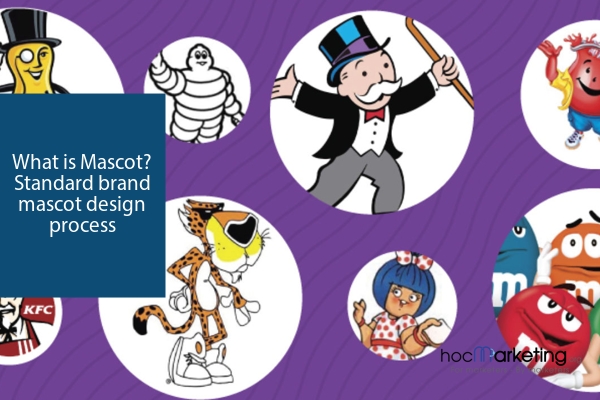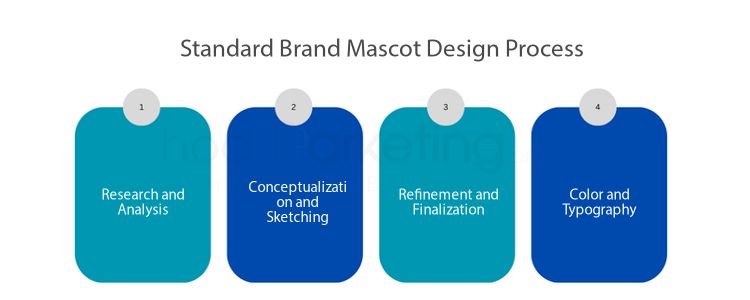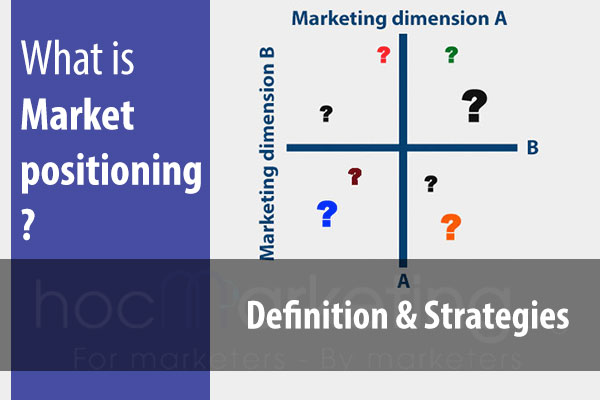
What is Mascot? Standard brand mascot design process

Learn about the importance of mascots in branding and the standard design process. Discover key factors to consider and successful examples. Improve your SEO content writing with this informative article.
Mascots have become an essential element in brand marketing and advertising. Whether it's Tony the Tiger for Frosted Flakes or the Geico Gecko, mascots are recognized and remembered by consumers. But what exactly is a mascot, and how does it fit into the branding process? In this blog post, we'll explore the definition of a mascot, its importance in branding, and the standard design process involved in creating one. We'll also discuss the crucial factors to consider when designing a mascot, such as brand personality, target audience, competition, and trends. Finally, we'll showcase some examples of successful brand mascots that have effectively captured the hearts of their target audience. So, let's dive in and explore the fascinating world of mascots!
1. What is Mascot?
A mascot is a character or an object that represents a brand, organization, or a team. It is designed to personify the values, mission, and personality of the brand and create an emotional connection with the audience. Mascots can take various forms, such as animals, humans, or abstract objects, and can be used in different contexts, such as advertising, packaging, or events. In this article, we will explore the importance of mascots in branding, the standard design process for creating a brand mascot, the factors to consider in mascot design, and examples of successful brand mascots.
2. Importance of Mascot in Branding
A mascot is an essential tool for branding purposes, and its importance cannot be overlooked. A mascot is a character or personification that represents a brand and serves as a symbolic figure for the company. It is a powerful branding tool that can help create a memorable and unique identity for a brand. A well-designed mascot can help a brand stand out from its competitors and help it to be recognized by consumers. The mascot can evoke emotions, create a connection with a target audience, and help build brand loyalty. In this section, we will discuss the importance of a mascot in branding and how it can help a brand achieve its marketing goals.
3. Standard Brand Mascot Design Process
The standard brand mascot design process involves several stages that are crucial in creating an effective mascot for a brand. The first stage is research and analysis, where the designer gets to know the brand, its values, target audience, and competition. This stage helps the designer gain insights into the brand and its audience, which are essential in creating a mascot that resonates with the target market.
The second stage is conceptualization and sketching, where the designer starts to create rough sketches of the mascot. This stage involves brainstorming ideas and coming up with different concepts that align with the brand's personality and values. The designer creates various sketches and selects the best ones to refine further in the next stage.
The third stage is refinement and finalization, where the designer selects the best sketches from the previous stage and starts refining them into more polished designs. This stage involves creating digital versions of the sketches and experimenting with different colors, typography, and layouts.
The last stage is color and typography, where the designer finalizes the color palette, typography, and other design elements of the mascot. This stage involves selecting the best colors that align with the brand's personality and creating typography that complements the mascot's design.
Overall, the standard brand mascot design process involves several stages that are crucial in creating an effective mascot for a brand. Each stage plays a vital role in ensuring that the mascot aligns with the brand's personality, values, and target audience.
Research and Analysis
Before starting the mascot design process, it is important to conduct thorough research and analysis. This step involves gathering information about the brand, its target audience, competition, and industry trends. The research helps in identifying the unique selling points of the brand and the values it wants to communicate through its mascot. It also helps in understanding the target audience's preferences, their age, gender, and interests. Knowing the competition and industry trends is crucial in creating a mascot that stands out and is relevant to the brand's industry.
Once the research is complete, the next step is to analyze the data and draw insights that can inform the mascot design. The analysis can help in identifying patterns and themes that can be incorporated into the mascot design. Understanding the target audience's preferences can also help in deciding the mascot's style, color, and personality.
Overall, research and analysis are critical in creating a mascot that accurately represents the brand and resonates with its target audience. Skipping this step can lead to a mascot design that fails to connect with the target audience and does not effectively communicate the brand's values.
Conceptualization and Sketching
Conceptualization and Sketching is the stage where the initial ideas and concepts are brought to life. Based on the research and analysis, the designer starts to sketch out rough ideas and concepts for the mascot. These sketches are usually created by hand, using pencil and paper, to give the designer more freedom and flexibility to explore different ideas. The sketches are then refined and developed into more detailed drawings, which are presented to the client for feedback and approval.
During this stage, the designer should focus on creating a memorable and unique mascot that reflects the brand's personality and values. The mascot should also appeal to the target audience and stand out from the competition. The designer should explore different styles, poses, and expressions to ensure that the mascot has a distinct and recognizable look.
Moreover, the conceptualization and sketching stage is an iterative process, which means that the designer may need to go back and forth between sketching and refining until the final design is approved. The designer should also consider the color and typography at this stage, as they can significantly impact the effectiveness of the mascot.
Overall, the conceptualization and sketching stage is crucial in creating a successful brand mascot. It allows the designer to explore different ideas and concepts until the perfect design is achieved. This stage requires creativity, attention to detail, and a deep understanding of the brand's personality, target audience, and competition.
Refinement and Finalization
After the conceptualization and sketching phase, the chosen design concepts are further refined and finalized. This is the stage where the mascot design starts to take shape and become tangible. The refinement process involves adding more details to the design, such as defining the facial features, body structure, and clothing or accessories.
During this phase, the design team works on making the mascot visually appealing while ensuring that it aligns with the brand's personality and values. The team also considers the target audience and competition while refining the mascot's design. They may conduct focus groups or surveys to get feedback on the design and make necessary adjustments.
Once the design is finalized, the team focuses on selecting the appropriate colors and typography. The color palette should complement the brand's existing colors and convey the desired emotional response from the audience. Typography is equally important as it can enhance the mascot's personality and add to its visual appeal.
Overall, the refinement and finalization phase is critical in bringing the mascot design to life and creating a lasting impression on the audience.
Color and Typography
When it comes to mascot design, color and typography play crucial roles in creating a memorable and effective brand identity. The colors chosen for the mascot should align with the brand's personality, target audience, and industry. For example, a children's brand mascot may incorporate bright and playful colors, while a professional services brand mascot may use more subdued and sophisticated colors.
Typography is also an important aspect of mascot design as it can communicate the brand's tone and personality. The font chosen should be legible and appropriate for the brand's industry and target audience. For example, a technology brand may use a sleek and modern font, while a vintage-inspired brand may use a more ornate and decorative font.
In addition to choosing the right colors and typography, it's also important to consider how they will be used in different contexts. The mascot should be designed to be scalable and easily recognizable across various mediums such as print, digital, and merchandise. Colors should be consistent across all platforms and typography should be legible at different sizes.
Overall, the use of color and typography in mascot design can greatly impact the success of a brand's identity. By considering the brand's personality, target audience, and industry, designers can create a cohesive and effective mascot design that resonates with consumers.
4. Factors to Consider in Mascot Design
When designing a mascot, there are several factors to consider to ensure that the mascot is effective in representing the brand. One of the primary factors is the brand personality. The mascot should embody the values and characteristics of the brand and be consistent with the overall brand image. This includes considering the tone and voice of the brand, as well as any brand messaging that the mascot will be used to communicate.
Another important factor is the target audience. The mascot should be designed with the audience in mind, taking into consideration factors such as age, gender, interests, and cultural background. The mascot should resonate with the audience and be visually appealing to them.
Competition is also a factor to consider in mascot design. The mascot should be unique and distinguishable from competitors' mascots, while still being relevant to the industry or market. A well-designed mascot can help a brand stand out among competitors and become more memorable to consumers.
Finally, trends in design should be considered when designing a mascot. While it's important to stay current, it's also important to consider longevity. A mascot that is too trendy may quickly become outdated and lose its effectiveness as a brand representative. It's important to strike a balance between staying current and creating a timeless design that can withstand the test of time.
In summary, the key factors to consider in mascot design include brand personality, target audience, competition, and trends. By taking these factors into consideration, a well-designed mascot can effectively represent a brand and become a memorable symbol for consumers.
Brand Personality
To create a successful brand mascot, it is important to take into consideration the personality of the brand. The personality of the brand is the set of characteristics that define it and differentiate it from its competitors. A brand's personality can be playful, serious, quirky, sophisticated, or any other attribute that aligns with the brand's values and image. When designing a mascot, the designer must consider the brand personality and ensure that the mascot reflects it accurately.
For example, a brand that sells children's toys may have a playful and cheerful personality. The mascot designed for this brand should reflect this personality by being colorful, fun, and engaging. On the other hand, a brand that sells luxury watches may have a sophisticated and elegant personality. The mascot for this brand should reflect this personality by being sleek, stylish, and refined.
In addition to reflecting the personality of the brand, the mascot should also be relatable to the target audience. The designer must consider the age, gender, interests, and preferences of the target audience when designing the mascot. For example, a brand that targets children may have a mascot that is cute, cuddly, and friendly. A brand that targets young adults may have a mascot that is cool, trendy, and edgy.
Ultimately, the brand mascot should be a representation of the brand and its values. It should be memorable, recognizable, and appealing to the target audience. By taking into consideration the brand personality and target audience, the designer can create a mascot that effectively communicates the brand message and strengthens brand identity.
Target Audience
When designing a mascot for a brand, it is important to consider the target audience. The mascot should resonate with the audience and appeal to their interests and preferences. For example, a mascot for a children's toy brand may have bright colors and playful features to attract young children, while a mascot for a luxury hotel brand may have a sophisticated and elegant design to appeal to affluent adults.
To determine the target audience, designers may conduct market research and analyze demographic data such as age, gender, income, and geographic location. This information can help inform the design choices and ensure that the mascot will appeal to the intended audience.
It is also important to consider the cultural context of the target audience. A mascot that may be well-received in one culture may not be appropriate or effective in another. Designers should be mindful of cultural nuances and avoid creating mascots that could be perceived as offensive or inappropriate.
Overall, considering the target audience is crucial in creating a successful brand mascot. By designing a mascot that resonates with the audience, brands can increase brand recognition and loyalty among their customers.
Competition
When designing a mascot for a brand, it is important to consider the competition. Understanding the market and what other companies are doing can give valuable insights into what works and what doesn't. It can also help ensure that the mascot design stands out from the competition and is unique to the brand.
One factor to consider is the type of industry the brand is in. For example, if the brand is in the food industry, it may be common to see mascots that are food-related, such as animals or characters made out of food. However, if the brand is in the technology industry, the mascot may need to be more abstract or futuristic in design to fit in with the competition.
Another factor is the tone and personality of the competition's mascots. If the competition has a playful and fun mascot, it may not be a good idea to design a serious and professional mascot for the brand. The mascot should reflect the brand's personality and differentiate it from the competition.
Overall, understanding the competition can help guide the design process and ensure that the mascot stands out in the market. It also allows for the opportunity to create a mascot that is unique to the brand and does not blend in with the competition.
Trends
In the ever-changing world of branding, it is crucial to stay up-to-date with the latest trends in mascot design. Trends in mascot design are not just about following the latest fad, but about ensuring that your brand stays relevant and appealing to your target audience. One of the current trends in mascot design is the use of minimalist designs that are simple, yet effective in conveying the brand's message. This trend is popular because it allows for easy recognition and recall of the brand mascot.
Another trend in mascot design is the use of anthropomorphic animals. Anthropomorphic mascots are those that have human-like qualities and behaviors. These mascots are popular because they are relatable and can evoke emotions and connections with the audience. Additionally, animals have always been a popular choice for mascots because they are universally recognized and can represent different qualities and characteristics.
A third trend in mascot design is the use of storytelling. Mascots that tell a story or have a backstory are more engaging and memorable to the audience. Storytelling can help to create an emotional connection with the audience and can help to reinforce the brand's values and message.
Finally, one of the most significant trends in mascot design is the use of digital and interactive mascots. With the rise of social media and digital marketing, mascots that can interact with the audience in real-time have become increasingly popular. Digital and interactive mascots can engage the audience in unique and creative ways, and can help to build a stronger relationship between the brand and its followers.
Incorporating current trends in mascot design into your brand can help to ensure that your mascot is engaging, memorable, and relevant to your target audience. While it is essential to stay up-to-date with the latest trends, it is also important to ensure that your brand's mascot reflects your brand's personality and values.
5. Examples of Successful Brand Mascots
Some of the most iconic brand mascots include Ronald McDonald, Tony the Tiger, and the Geico gecko. These mascots have become synonymous with their respective brands and have helped to create a strong emotional connection with consumers. Successful brand mascots are often memorable, relatable, and distinctive. They can be used in advertising campaigns, on packaging, and in other marketing materials to create a consistent brand identity. In this section, we will explore some examples of successful brand mascots and look at how they have helped to build brand recognition and loyalty.
Summary
In conclusion, having a mascot for your brand can be a powerful tool in establishing brand identity and recognition. By following the standard design process, you can ensure that your mascot accurately represents your brand and appeals to your target audience. Remember to consider the values and personality of your brand, as well as the preferences of your audience, when choosing and designing a mascot. With a well-designed mascot, you can strengthen your brand image and connect with your customers in a fun and memorable way.













